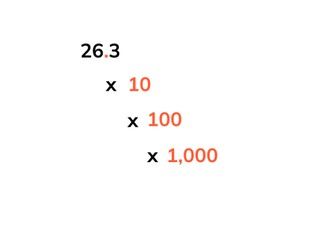
Multiplying decimal numbers with 10, 100, and 1,000
Students learn to multiply decimal numbers with 10, 100, and 1,000.



8,000 schools use Gynzy
92,000 teachers use Gynzy
1,600,000 students use Gynzy
General
Students learn to multiply decimal numbers with 10, 100, and 1,000.
Standards
CCSS.Math.Content.5.NBT.B.7
Learning objective
Students will be able to multiply a decimal number by 10, 100, or 1,000.
Introduction
There are four problems on the interactive whiteboard in which one number must be multiplied by ten, such as 2 x 10. There are also four problems in which one number with two digits must be multiplied by ten, such as 31 x 10. Have the students solve these problems and discuss what happens when you multiply a number by ten. You repeat that when you multiply by ten, a zero is added to the number.
Instruction
You explain that when you multiply a decimal number with ten, the decimal point moves one place to the right. Along with this, also explain that when you multiply by ten if you don't have a decimal point in the number, you add a zero to the number. You can see if the students have understood this by solving the problems on the interactive whiteboard together. Next you explain that when you multiply a decimal number by one hundred, the decimal point moves two places to the right. When you only have one number behind the decimal point, move the decimal point one place to the right and put a zero after the number. You can also have the students practice this by solving the problems on the interactive whiteboard. Finally you explain that when you multiply a number by one thousand, the decimal point moves three places to the right. When you only have one number behind the decimal point, you move the decimal point one place to the right and then put a zero after the number. If you have two numbers behind the decimal point, you move the decimal point two places to the right and put one zero after the number. You can also practice multiplication by one thousand by solving the problems on the interactive whiteboard together with the students. At the end of the instruction you solve two story problems together with the students, for which the students must solve the multiplication problems.
To check whether students can multiply decimal numbers with 10, 100, and 1,000, you can ask the following questions:
- What happens when you multiply a decimal number with ten/one hundred/one thousand?
- What do you do if you no longer have a decimal point in the number?
- What is the solution to the problem 53.29 x 1,000?
Quiz
The students test their understanding of multiplying decimal numbers by 10, 100, and 1,000 through ten exercises. For some of these they must multiply a number by 10, others by 100 and others by 1,000. Some of the problems are story problems.
Closing
You discuss once again with the students that it is important to be able to multiply with 10, 100, and 1,000, because that is how you can quickly solve problems. You discuss what you do if you multiply a number by one thousand and when you put a zero after the number. Next you do the exercise on the interactive whiteboard, in which the students must calculate the answer to the problem. Drag the correct answer to the problem.
Teaching tips
When students have difficulty with multiplying with 10, 100, and 1,000, the students can draw out the lines like the ones on some of the problems from the lesson. Then they can see how many jumps they are making with the decimal point.
The online teaching platform for interactive whiteboards and displays in schools
Save time building lessons
Manage the classroom more efficiently
Increase student engagement
Discover more!
About Gynzy
Gynzy is an online teaching platform for interactive whiteboards and displays in schools.
With a focus on elementary education, Gynzy’s Whiteboard, digital tools, and activities make it easy for teachers to save time building lessons, increase student engagement, and make classroom management more efficient.



